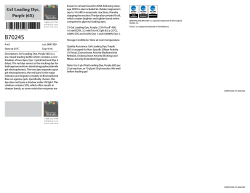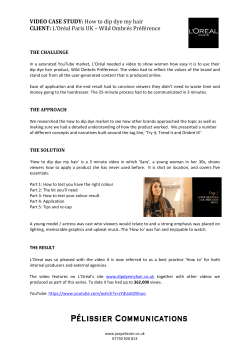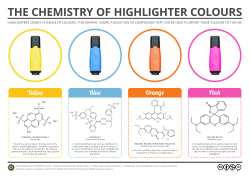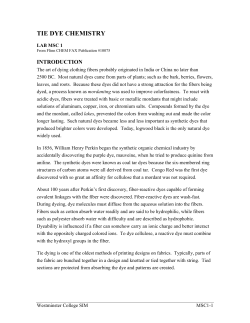
Chemical Mixing & Handling
metalphoto APPENDIX B CHEMICAL MIXING & HANDLING B-100 CHEMICALS FOR METALPHOTO AND PRE-DYED METALPHOTO PLUS PROCESSING B-1O1 ZIP DEVELOPER AND ZIP FIXER Zip Developer and Zip and Tray Fixer are packaged full strength, ready to use in Zip Processors. DO NOT DILUTE. B-102 TRAY DEVELOPER AND FIXER Use Metalphoto Tray Developer for tank or tray processing. Mix 1 part developer to 3 parts distilled or deionized water. Always discard used tray developer. Use Metalphoto Zip and Tray Fixer diluted 1 part fixer to 3 parts distilled or deionized water. Always discard used fixer. B- 110 CHEMICALS FOR PRE-DYED AND CLEAR ULTRACOLOR B-111 DEVELOPER Use a dilute, aqueous solution of hydrogen peroxide available in drugstores in a 3% solution. Dilute this solution with 9 parts of cold water to 1 part of the 3% peroxide to make a 0.3% solution. Only prepare enough fresh developer for one day’s use. Discard any pre-mixed unused developer each day. B-112 DYES Use Metalphoto Solvent Soluble InstaColor Dyes or PolyColor Dyes for dyeing Clear UltraColor. Metalphoto InstaColor Dyes should be dissolved in anhydrous isopropyl alcohol available from a chemical supply house. DO NOT USE RUBBING ALCOHOL available in drugstores because it contains water. Dissolve the contents of 1 package of InstaColor dye in 1 quart of solvent. Mix dyes in a well-mately 25 parts deionized or imaging ventilated area away from sparks and heat sources. Make sure all of the dye powder is dissolved in solvent before use. It is best to prepare the dye solution the day before use to insure complete solution of the powder. Keep dye container capped (to reduce solvent evaporation) while applying dyes! Use Metalphoto pre-mixed PolyColor Dye Solutions as is. Always work in a wellventilated area away from sparks and open flames. B-113 BLEACH UItraColor Bleach is bottled full strength ready to use. DO NOT DILUTE. Use only in a plastic tray and store the unused solution in its original container. Do not put partially used bleach back into the original container. Store in another tightly capped plastic or glass container. UltraColor Bleach contains acid and is corrosive. Rubber gloves, protective rubber apron, and goggles or safety glasses are recommended for safety. B-114 CLEANER UltraCoIor Cleaner comes as a dry powder that must be dissolved in water before use. Dissolve the contents of 1 package of UltraColor Cleaner in 1 gallon of warm deionized or distilled water. Place a small quantity of the resulting solution in a plastic tray for use. Discard used cleaner solution. B-120 CHEMICALS FOR SEALING AND POLISHING 602 MIXING SEALING BATH Metalphoto Liquid Sealing Concentrate and Metalphoto No-Nickel Liquid Sealing Concentrate are each packaged in plastic gallon bottles. Prepare either sealing bath by mixing 1 part of Sealing Concentrate to approxi- B-1 metalphoto APPENDIX B CHEMICAL MIXING & HANDLING distilled water according to the package instructions in a Type 316 stainless steel tank. Heat the solution to boiling for use. IMPORTANT: Tap water contains minerals which interfere with the sealing process and must not be used for preparing the bath or subsequent replenishment. B-122 POST SEALING TREATMENT Metalphoto Post Sealing Treatment comes as a liquid concentrate. Dilute with tap water. Follow label instructions for dilutions for our standard tank capacities. B-125 POLISH Metalphoto Polish requires no mixing or diluting. B-130 CHEMICALS FOR IMAGE INTENSIFICATION OF METALPHOTO PLATES B-131 METALPHOTO IMAGE INTENSIFIER Metalphoto Image Intensifier is supplied as a two component system. Follow instructions on the packages. All equipment and storage containers used for mixing, storing or using Image Intensifier must be made of plastic or glass. Metal materials contaminate Image Intensifier. The following instructions apply to mixing a 5-gallon batch. Other volumes are prepared proportionately. Fill a clean, plastic or glass 5-gallon container with 4 gallons of deionized or distilled water. Add the entire contents of the bottle of gold chloride and stir thoroughly with a clean, plastic or glass rod. In a separate glass container, heat 1 gallon of deionized or distilled water to at least 125°F (52°C). Add some of the hot water to the jar IMPORTANT: Isopropyl alcohol is a imaging of ammonium thiocyanate until the jar is nearly full. With a clean glass or plastic stirring rod, stir the ammonium thiocyanate until all the powder is completely dissolved. Without cleaning the rod (used to mix the ammonium thiocyanate solution), use it to stir the diluted gold chloride solution. Stir the gold chloride solution until it changes from red to milky white. A few additional drops of ammonium thiocyanate solution may be necessary to make the gold chloride turn milky. The gold chloride solution will turn from milky to clear when enough drops of ammonium thiocyanate have been added to “prime” the gold chloride solution sufficiently. Now slowly add the ammonium thiocyanate solution to the gold chloride solution while continuing to stir. Stop adding if the solution becomes red and continue stirring until it clears. Continue the procedure to completely blend the two solutions. When the two solutions are completely blended, add water to bring the total to 5 gallons. Store in an air-tight plastic or glass container. Use of a brown bottle extends the life of the solution. Avoid storage in a warm area. Never return partially used solutions to original containers. Never use a tray that has been used for image intensification for any other purpose. B-140 CHEMICALS FOR DYEING B-141 INSTACOLOR DYES Dissolve the entire contents of 1 package of Solvent Soluble InstaColor Dye powder in 1 quart of anhydrous isopropyi alcohol. The quantity of dye per package is formulated for use with anhydrous isopropyl alcohol only. DO NOT USE RUBBING ALCOHOL since it contains a significant amount of water which destroys the effectiveness of the dye. B-2 metalphoto APPENDIX B CHEMICAL MIXING & HANDLING imaging flammable solvent. Do not use it near arc lights or other open flames. Make sure you have adequate ventilation. Stir the dye solution thoroughly to be sure that all of the dye powder is completely dissolved in the solvent. B-142 INSTACOLOR RESIST InstaColor Resist is packaged full strength, ready to use. B-145 BACKGROUND DYES Metalphoto Water Soluble Background Dyes are mixed as follows: Dissolve the contents of 1 package of dye in approximately 1 quart of deionized or distilled water that has been preheated to near boiling. Stir until all of the dye is in solution. Add deionized or distilled water to bring the total solution volume to 1 gallon. Deeper (darker) colors can be achieved by increasing dye solution concentration (i.e., mix with less water), lengthening immersion time in the dye solution or warming dye solutions normally run at room temperature. Lighter shades can be achieved by diluting the dye solution with deionized water and/or decreasing immersion time. The use of a partial package of dye is not recommended. Some of the colors are produced by combining several individual dyes in a precise ratio. Failure to use the entire contents of a package can produce a variation in the expected color. Color hue is affected by the pH of the dye solution. Adjustments to the pH of the solution may be necessary. The proper pH for each Metalphoto Water Soluble Background Dye is shown in the adjacent table. If the pH of the dye solution is too low, add drops of 1% solution of sodium hydroxide. If the pH is too high, add drops of acetic acid. In order to get a proper pH reading after the correcting drops are added, the solution must be completely mixed and stirred and then checked with a pH meter. The importance of proper pH control in dyeing cannot be overemphasized. Once the dye solution is adjusted to the proper pH, it is ready for use. For maximum color consistency, monitor and maintain pH. A change of less than 0.5 in pH can significantly alter the hue and color intensity of dyed plates. B-146 DYE-N-SEAL Dissolve the contents of 1 Dye-N-Seal package in 2 gallons of boiling deionized or distilled water in a clean, stainless steel sealing tank. Remove 1 quart of this solution to use for subsequent replenishment. After 1 quart is removed, add deionized or distilled water to this Dye-N-Seal Solution to make a total of 3-1/2 gallons of working solution. Dye-NSeal solutions should have a pH of 5.5 for optimum results. B-3 metalphoto APPENDIX B CHEMICAL MIXING & HANDLING imaging B-150 GENERAL INFORMATION WORKING CAPACITIES OF METALPHOTO EQUIPMENT B-151 STORAGE Store chemicals used with Metalphoto products in a cool, dry place. Most chemicals are adversely affected by high temperatures and humidity or temperatures which are too low. If the storage area is below 65°F (18°C), be sure to allow chemicals to warm to 68 to 72°F (20 to 22°C) before using. Never allow chemicals to freeze. PART NO. DESCRIPTION B-152 SHELF LIFE The shelf life of all Metalphoto chemicals is one year, provided the seal remains unbroken and storage temperatures do not exceed 90°F (32°C). In practice, this limitation applies primarily to the liquid chemicals such as developer and fixer for Zip and tray processing. PLATE SIZE CONVERSION TABLE To convert number of plates processed from 10” x 12” to: 8” x 10” - multiply by 1.5 12” x 20” - divide by 2 20” x 20” - divide by 3.33 20” x 24” -divide by 4 20” x 40” - divide by 6.66 B-4 WORKING CAPACITY 7812 14-7 ZIP PROCESSOR Developer reservoir Fixer reservoir 1 quart 2 quarts 7860 28-7 ZIP PROCESSOR Developer reservoir Fixer reservoir 3 quarts 1 gallon 8260 SEALING TANK FOR 10” x 12” PLATES 3.5 gallons 8285, SEALING TANK FOR 7892 12” x 20” PLATES 7 gallons 8300, SEALING TANK FOR 7894 20” x 24” PLATES 25 gallons 8320, SEALING TANK FOR 7896 24” x 40” PLATES 30 gallons 8340 RINSE TANK FOR 12” x 20” PLATES 7 gallons 8350, RINSE TANK FOR 7854 20” X 24” PLATES 25 gallons metalphoto APPENDIX B CHEMICAL MIXING & HANDLING B-5 imaging metalphoto APPENDIX B CHEMICAL MIXING & HANDLING B-6 imaging
© Copyright 2025









